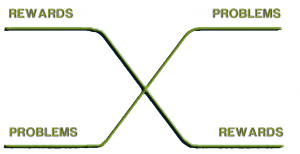When we’re dealing with addictions and other complex disorders that have become deeply embedded over the course of years, it helps to alter our change paradigm.
A ‘change paradigm’ being a model for understanding how change occurs in a certain situation.
With addiction, we begin by reversing the principal question. Instead of ‘how do we get someone else to change?’ we ask: ‘why hasn’t he or she changed already?”
Because if a problem is bad enough to motivate other people to seek help for the alcoholic, it certainly should have motivated the alcoholic, long before now. After all, he’s the one who’s experiencing it.
Our revised question should yield a list of obstacles or barriers that prevent the alcoholic from doing what’s necessary. We can then strategize their removal.
Our assumption is that with a longstanding problem behavior that has progressed over time, the natural momentum is towards change, not away from it.
The progression of addiction looks something like this:
As consequences mount – which can happen quickly or over the course of years – motivation for change should increase.
And yet, in many cases it doesn’t. The addict remains unmotivated, even in the face of significant dysfunction.
Why? Because there are barriers standing in the way of change.
We can divide these barriers into 3 broad categories.
Defenses: The more problems mount, the more anxious we become. It becomes necessary for our brain to manufacture psychological defenses to protect us from that anxiety. These center on reduced awareness of the potential dangers — and the future risks that await us.
Stigma: Addiction is still socially unacceptable. Society has stigmatized it. We’re taught to look down on addicts and alcoholics as weak and morally inferior, and since they grew up in this same society, they share these attitudes. Guilt, shame, and social penalties weigh heavily on the mind of an alcoholic contemplating change.
Enabling and provoking: Many respond to someone else’s addiction by enabling (rescuing, protecting) or provoking (inciting) it. Unfortunately, such responses prolong the behavior, to everyone’s detriment. Most enablers and provokers act from relatively good intentions.
The process of identifying barriers to change, and then setting out to remove them, is called ‘thinking backwards’. It turns out to be a key to successful intervention.
Three observations based on experience:
- Changing the behavior of those around the alcoholic is a key to motivation
- The behaviors we abandon may be as important as any steps we take.
- Change is ultimately about action, rather than insight. In fact, real insight often follows change.
This altered paradigm works in part because addiction engenders increased dependency on other people – an escalating dependency that provides leverage that can motivate change – provided those around the alcoholic learn to recognize and use it.










